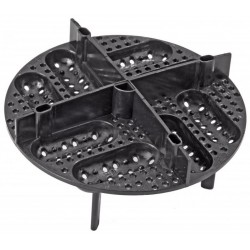

It was concluded that tilting and incubating eggs is not a viable alternative to conventional turning practices. Malposition II predominated in the tilted groups oriented 45 degrees or horizontally, whereas Malposition III predominated in the controls and in the tilted groups oriented vertically.

Late incubation embryonic mortality was elevated in the tilted groups, and the frequency of malpositions increased. Depressions were cumulative and additive, with significant depression for all eggs tilted during the 1st wk of incubation, and diminished effects in the 2nd and 3rd wk. Tilting instead of turning depressed hatchability regardless of orientation. Comparisons were made in terms of the hatchability of fertile eggs, hatchability of transferred eggs, embryonic mortality, and malpositions. Eggs were oriented either vertically (large end up), at a 45-degree angle, or horizontally. At hourly intervals, eggs were tilted 45 degrees in opposite directions for consecutive intervals and returned to their original orientation. Six experiments were conducted to examine the feasibility of “tilting” instead of turning chicken eggs during incubation to provide a near-constant airflow pattern.

There are two types of rolling mechanisms. Just a reference) The Roller Type Incubator See how a typical swing-type incubator works below (Note: this is not our video.

The egg tray then is attached to a lever connected to the motor which makes the tray tilt usually 45 degrees back and forth depending on the frequency set on the timer. The swing-type incubator uses commercially manufactured egg trays. The swing type (tilting), and the rolling type. There are two most common types of incubators. If you are to assemble your own incubator, the challenge could be bigger especially if this is the first time that you are going to try building one.įrom the basic container, carton, or styrofoam box incubator where you turn eggs manually 3 times per day, set the temperature, and add water to a reservoir to provide the correct humidity, to the fully automatic incubator that can set temperature and humidity for the right species with the press of a button, we look at the two most important things you might want to consider before you invest some money in buying or building your first incubator. There are many different models and variants to incubate your hatching eggs and each model is slightly different having different levels of functionality. Choosing the right incubator for your hatching needs can be a daunting task. There are two types of incubators – the roller type and the swing type incubator.


 0 kommentar(er)
0 kommentar(er)
